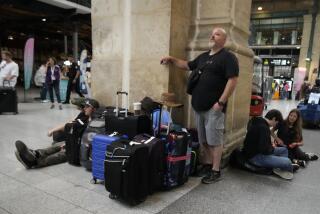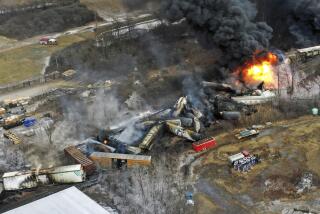Violent protests and general strike roil cities across Greece

- Share via
ATHENS, Greece — Riot police fired volleys of tear gas, stun grenades and water canon at protesters hurling gasoline bombs and smashed-up paving stones in Athens on Friday during a massive demonstration marking the second anniversary of Greece’s worst rail disaster that has become a symbol of institutional failure.
Hundreds of thousands of people took to the streets in cities across the country as part of a general strike called to demand justice for the 57 people killed on Feb. 28, 2023, when a passenger train collided head-on with a freight train.
Among the largest demonstrations since Greece’s debt crisis a decade ago, Friday’s protests were fueled by public resentment against the conservative government’s perceived lack of accountability in the wake of the disaster, and the slow pace of the investigation.
Violence also broke out on the fringes of a protest in the northern city of Thessaloniki, where dozens of hooded protesters broke away from the main rally to clash with riot police.
In Athens, repeated rounds of clashes near Parliament left at least 20 people requiring medical attention, authorities said. Police said 120 people were detained, with 27 of them arrested. Confrontations spilled over into nearby streets, with groups of hooded protesters entering an archaeological site near the ancient Roman monument of Hadrian’s Arch and pelting riot police with rocks.
Unions called a general strike in support of the mass mobilization led by the victims’ relatives. Critics say that politicians should be held accountable for failures that led up to the collision, but so far only rail officials have been charged with any crimes.
The rail disaster in Tempe left dozens injured and exposed deficiencies in transportation infrastructure.
“The full truth must come to light, and those responsible, no matter how high their position, must be held accountable,” said Yannis Panagopoulos, president of the General Confederation of Greek Workers, the country’s largest labor union, which has backed Friday’s strike.
Flights and rail services were canceled, ferries halted and public transportation was severely disrupted. Businesses and public services have also been affected, with many stores in Athens and other cities closed, leaving messages of solidarity for the victims’ families in front windows.
Demonstrations were taking place in more than 300 cities and towns in Greece and abroad. Protesters in Athens, chanting “You count profits. We count lives,” carried black balloons and anti-government banners and blared aerosol horns.
Athens municipal worker Costas Reintzopoulos said the rail crash had highlighted longstanding demands for safer working conditions; eleven of those who died were railway employees.
“Every day, there is a demand to know the truth about what happened, and every day there is demand for better safety measures in the workplace. That is a key reason why this remains relevant,” he said. “We don’t want to mourn more dead people, who leave in the morning to go to work and we don’t know if they’ll come back.”
Memorial services were held at Orthodox churches in Athens for the victims, who included many university students returning from a long weekend. Their families had urged protesters to remain peaceful and keep the focus on remembrance rather than politics.
Yet the demonstrations have created a politically precarious moment for Prime Minister Kyriakos Mitsotakis’ government.
His conservatives maintain a strong lead in the polls, but public dissatisfaction over the Tempe disaster has led to surging support for anti-establishment parties on both the left and right. Opposition leaders, who are struggling to gain traction, are weighing whether to put forward a censure motion.
Mitsotakis promised to continue work to improve rail safety, adding: “Every Greek participates in this mourning, united under the common demand for truth.”
The mountainous country is largely road-reliant and the Greek railway system is centered on a single route between Athens and Thessaloniki, a fact that made the collision harder for many to understand.
A long-awaited report from the investigation into the crash, released Thursday, blamed human error, outdated infrastructure and major systemic failures for the head-on collision.
Surviving passengers described tumbling carriages, fires and smashed windows as they scrambled to escape. Bodies were severely burned or dismembered. Funerals across Greece, many streamed or broadcast live, turned private grief into a shared national experience.
Hours after the collision, Maria Krystianou rushed to the scene of the tragedy to search for her missing daughter, 21-year-old Maria-Thomai, as the train cars still smoldered. After a two-day wait, Maria-Thomai’s death was finally confirmed with a DNA match.
Krystianou, a 52-year-old pediatrician, has since become a leading figure in the campaign to hold politicians to account for the crash. This week she publicly thanked unions and associations that joined the protests, including doctors at public hospitals, and lawyers and judges who will hold a minute’s silence in courts Friday.
“For those of us who had our children and loved ones on that train, a part of us remains with them and will never return. The unrelenting pain and the unimaginable reality are with us forever,” Krystianou told a crowd outside parliament. Pointing to the protesters, she added: “This is for you, my girl, and for those of us who never made it.”
Gatopoulos and Becatoros write for the Associated Press. AP journalists Lefteris Pitarakis and Theodora Tongas in Athens and Costas Kantouris in Thessaloniki contributed to this report.










